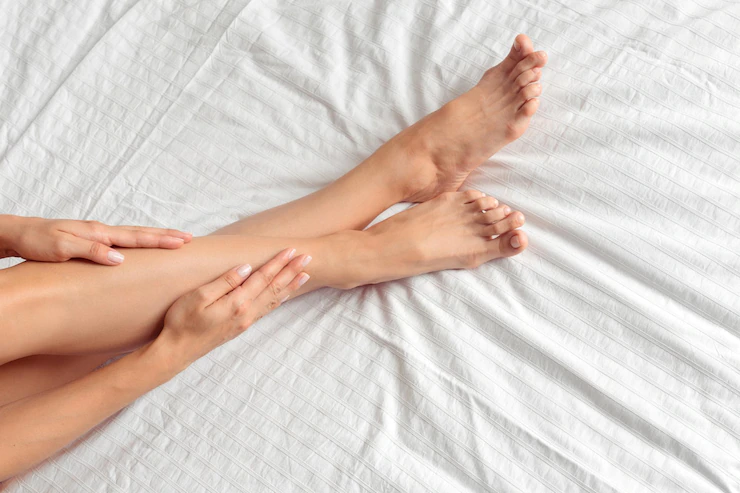Seventy-five percent of Americans will experience foot pain. The foot contains 26 bones, 133 joints, 107 ligaments, and 19 muscles. The average wear and tear on a foot is equivalent is the distance a person covers in a lifetime, which is about 115,000 miles. Physical aliments can first manifest in the foot, including diabetes, arthritis, peripheral vascular disease, and cardiac disease. A foot out of alignment results in discomfort and pain to the foot, ankle, knee, hip, and back.

Recently we had a chance to sit down with Dr. Ira Spinner to discuss some common foot ailments. Dr. Spinner is a Fellow of the American College of Foot and Ankle Surgeons. He is member of the American Board of Podiatric Surgery, American Podiatric Medical Association and a member of the wound care team at Delray Medical Center. Dr. Spinner is board certified on foot surgery.
Q: Why would I go to a podiatrist over an orthopedist or dermatologist for a foot condition?
A: The choice is yours. These professions study the same conditions. In podiatry, our education is specific to all aliments from the knee on down. Always go by the recommendations, and choose a doctor who is board certified.
Q: How important is shoe gear? Isn’t it natural just to go bare footed?
A: The foot is designed to be a mobile adaptor to terrain, such as dirt and sand. Today we walk on hard surfaces such as tile, concrete, and wood flooring. In adapting to surfaces, the foot over compensates in pronation (rotating the foot inward) and supination (turning the sole upward). Both excessive motions send forces through the foot and up the body, as in a chain with many links. The negative effects of these forces on muscles and joints can result in foot, ankle, knee, hip, back, and neck pain. We must rely on a shoe to cradle the foot and absorb these forces. A good shoe includes a heel or wedge, a midsole, a strong shank and heel counter, a supportive arch bed, and a rubber sole. For general walking and exercise, choose an athletic shoe to wear. Since no two feet are alike, pick a name brand sneaker that fits your foot. Sneakers should be a half size to a full size bigger than your normal size. For dressy or casual shoes, look beyond pretty and choose a shoe with a wide toe box. The heel should be between – 1 inch high. Avoid flats and high heels. I recommend a rubber sole over a leather sole. I like a sandal that has a full arch bed and a wedge design. The sandal should have a minimum of two straps with one for around the ankle. Look for comfort over style. Sometimes it is painful to look pretty, especially when wearing shoes that contribute to misaligning your whole body, causing pain and permanent damage to joints.
Q: Can you explain the difference between a heel spur and plantar fascitis? I know they cause heel pain.
A: The symptoms are identical. Individuals usually describe their pain and discomfort when they first arise or after sitting for long periods. The plantar fascia is a large band-like structure that runs from the ball to the heel of your foot. Its main purpose is to stabilize the arch. With increased activity and age, the plantar fascia becomes less like a rubber band and more like a rope. By losing its flexibility, it becomes more vulnerable to trauma, which can be acute or comes gradually when caused by excessive walking in improper shoe gear. The pain is caused by inflammation or an accumulation of fluid at the fascias insertion to the heel. When enough force is present to the body, it will try to protect the heel by forming a calcific spur, which is off the weight-bearing surface and is not the cause of the pain. The spur is only a symptom and is not addressed when surgery is necessary.
Q: How can I prevent heel pain, and what are good common treatments?
A: Prevention is always the best care. Stretching and proper shoe gear, which includes an orthotic, can prevent heel pain. Once the fascitis or inflammation occurs, treatments include non-steroidal anti-inflammatories, physical therapy, ice, shoe modifications, steroid shots, and as a last resort, surgery. Before you see a physician, try rolling a golf ball in your arch for ten minutes, followed by ice for 20 minutes for three weeks daily. After the first week, add stretches. The simplest stretch is to take a phone book or a block of wood 2-3 inches high, rest the ball of your foot on it and let your heel drop to the floor. Relax, then stretch for 30 seconds and repeat three times.
Q: You mentioned orthotics. How important are they?
A: The foot is the foundation for the body. Like any other structure, the body and foot need a strong foundation. A custom arch support is designed to contour each person’s unique arch. The orthotic increases support and allows for shock absorption. If we all wore orthotics, many orthopedic aliments would be avoided.
Q: You have been very technical to this point. What is the story with pedicures? If I continue to go to my salon, am I bound to get one of those fungal monsters I see on the T.V. commercials?
A: No. Choose a salon for its reputation, not for its savings. Make sure all the instruments are in a sterile pack or tray containing a sterilant. Make sure all tubs are cleaned and sterilized before putting your feet into them. If you suffer from diabetes, salons are okay. If you are cut, make sure to see a podiatrist right away. Because the salon’s bottles are in contact with other customers’ toes and their possible conditions, it is a good idea to bring your own nail polish.
Q: What can be done to treat toenail fungus?
A. Nail fungus is common, and it is purely cosmetic. Prevention includes drying your feet thoroughly after baths and showers, applying a small amount of powder to your feet, and changing your socks and shoes daily. Allow the leather in shoes to dry out for a day. Typical remedies are mostly ineffective. My patients have used self-help remedies including vinegar, Vicks, Listerine, tea tree oil, and bleach. These remedies will change the texture of the nail and color; however, they usually fail to kill the tiny microscopic spores that cause the fungus. I do recommend oral agents when cosmetic appearances are a concern. When used properly, oral medicines are very effective with few side effects.
In my office, I treat everything from skin and nail infections to orthopedic conditions, including foot trauma, bunions, hammertoes, neuromas, fascitis, arthritis, and many other foot aliments. Most can be avoided with good hygiene, along with the proper footwear. I recommend stretching your muscles and joints on a daily basis. It is important to perform a minimum of 30 minutes of cardiac exercise a 3 – 4 times a week. You do not need an exercise facility to walk. If you do not have the time, get up 15 minutes earlier a go to bed 15 minutes later, you will actually feel less tired and have an overall sense of well being. The foot is a mirror to your overall body health. Take care of your feet, and your body will stay strong.
_________________________________________________
Dr. Ira Spinner, D.P.M., F.A.C.F.A.S. is located in Boynton Beach, Florida. Fellow, American College of Foot and Ankle Surgeons; Member, American Board of Podiatric Surgery, American Podiatric Medical Association and a member of the wound care team at Delray Medical Center



